Moira Butterfield's Blog, page 72
March 5, 2014
Tweeting Traditional Tales
 One of the three Billy GoatsI started to teach creative writing and writing picture books around three years ago. During that time I've experimented with different ways to encourage students to practice their writing skills. One of the methods I've successfully used is to encourage students to recreate old stories by using tweets. If you've never heard of Twitter (and tweets) the idea is to create a message using just 140 characters, including the spaces.
One of the three Billy GoatsI started to teach creative writing and writing picture books around three years ago. During that time I've experimented with different ways to encourage students to practice their writing skills. One of the methods I've successfully used is to encourage students to recreate old stories by using tweets. If you've never heard of Twitter (and tweets) the idea is to create a message using just 140 characters, including the spaces. So rather than cover a topic I've decided to set a challenge for the visitors to The Picture Book Den.
Next time you have ten minutes free choose a fairy tale and become one of the characters. Create a series of tweets that tell that characters side of the story.
To demonstrate what I mean here is my retelling of 'The Three Billy Goats Gruff' from the point of view of the troll. If you've never read the story then follow this link.
Woken this morning by a small goat trying to cross my bridge without paying a toll #angrytroll
This morning caught a second goat trying to sneak across my bridge without paying toll. Can't believe how rude goats can be. #angrytroll
Discovered a third goat attempting to cross bridge without paying toll. He even head butted me! #angrytroll
How do these goats expect me to stay in business? No toll, no bridge, no way to cross river to eat delicious grass! #angrytroll
Reluctant sale of bridge, been in family for generations. License to charge toll. High daily foot fall. #businessforsale
Note: Using a hash tag before a term allows other Twitter users to find your tweets by using the same term.
I'm hoping if you give this a go you can see how you can have fun with a well-known story, make it your own and practice your craft. This process may not lead to a published book but it does give you the opportunity to exercise your writing muscle in a fun way.
If anyone does give it a go please do share your results here.
Regards
Lynne
P.S. Follow me on Twitter and I promise to follow back @lynnegarner
P.P.S. The goat used to illustrate this piece is a free download (which I've rendered) from my website Anansi Spider Stories - if you have kids then please visit there are loads of free colouring pages you can download.
Published on March 05, 2014 23:00
March 1, 2014
Introducing... Michelle Robinson
 Hello, I'm children's author Michelle Robinson. Thank you for welcoming me into the Picture Book Den! I've been reading the blog for a long time, so I feel very honoured to find myself ‘on the inside’. I thought my first post ought to be an introduction - after all, contrary to the belief of anyone who asks me what I do for a living, there’s absolutely no evidence that I am indeed ‘the next JK Rowling’, so you probably won’t have heard of me. Yet.
Hello, I'm children's author Michelle Robinson. Thank you for welcoming me into the Picture Book Den! I've been reading the blog for a long time, so I feel very honoured to find myself ‘on the inside’. I thought my first post ought to be an introduction - after all, contrary to the belief of anyone who asks me what I do for a living, there’s absolutely no evidence that I am indeed ‘the next JK Rowling’, so you probably won’t have heard of me. Yet. 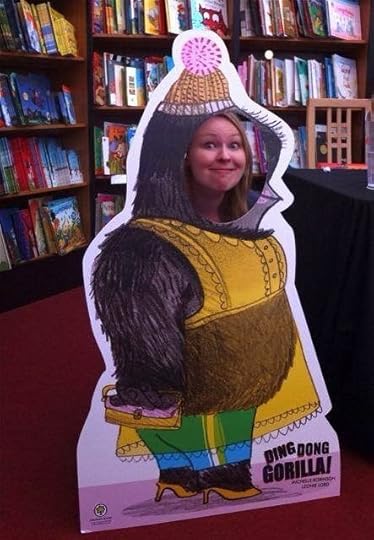 My first picture book came out in 2012, I’ve now got ten on the shelves, another ten in production, many more doing the rounds and a squillion duff ones cluttering up my desktop. Maybe I’m not the next JKR, but I'll happily settle for The First Me.
My first picture book came out in 2012, I’ve now got ten on the shelves, another ten in production, many more doing the rounds and a squillion duff ones cluttering up my desktop. Maybe I’m not the next JKR, but I'll happily settle for The First Me.FACTS: I love picture books and am woefully short on shelf space.
I used to be an advertising concept bod and copywriter. I wrote radio ads for a long time, so setting up ideas and resolving them quickly - as well as reading them aloud - set me up well for writing picture books.
I met fellow Picture Book Denner, Malachy Doyle on an Arvon course that he tutored some years ago. It was through his help and guidance that I found my agent and got published. Malachy will be on my Christmas list forever.
When writing, I try to choose the simplest words and use as few as possible. I chuck in the odd big word as I don’t believe in talking down to children. Books are a great place to learn new words. (As a child, I adored reading the dictionary. Still do.)
I got majorly into reading when I moved schools aged five, spotted a girl with her head in a Famous Five book and thought 'That looks fun'. She became my best friend and I spent all my pocket money on second hand Blytons.
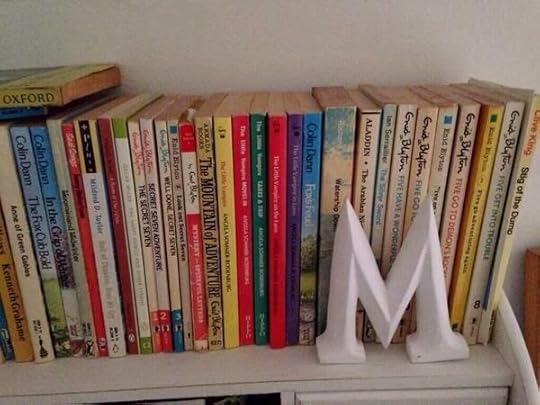
I always dreamed of becoming a children’s author. My dad told me it didn’t matter that we weren’t rich; I could achieve anything I wanted if I worked hard enough. I believed him; I believed in myself. I worked hard and my dream came true. I can’t tell you how incredible that feels. Now I give my own children the same advice my dad gave me - and I have my very own books to back it up.
 I have two children, Arthur (four) and Heidi (two). They take up most of my time, which is magic - but I do appreciate the two mornings a week when they're at nursery and I can write (and iron, vacuum, bake, eat all the baking, etc.).
I have two children, Arthur (four) and Heidi (two). They take up most of my time, which is magic - but I do appreciate the two mornings a week when they're at nursery and I can write (and iron, vacuum, bake, eat all the baking, etc.).I'm Patron Of Reading for my local first school. It's brilliant. I get to spend time with wonderful kids and introduce them to brilliant books they might not otherwise encounter.
My pet publishing hate is people being secretive about the road to publishing. There's always space on the shelves for more great books, and children deserve quality. I'm always happy to share any 'wisdom', hence my website features a regular-ish advice section called Pencil Tips.
I like cake a little bit too much.
Finally - violins at the ready - I'm writing this from a hospital bed. I'm currently getting hardcore drugs and custard free on the NHS, and attempting to write a first draft of a children's novel while I'm bed bound. It's not going terribly well. I blame the high temperature.
I'm really looking forward to contributing to the Den and getting to know you all a little better. With warmest wishes (currently about 38°), Michelle Robinson
For more on Michelle Robinson, including writing advice, colouring sheets and free audio games to accompany her picture books, visit her website.
Published on March 01, 2014 00:30
February 23, 2014
The SAS Conference 2014 by Abie Longstaff
This weekend I met up with forty-one other children’s authors in a secret location (ok it was Peterborough) to talk about all aspects of writing children’s books, from the initial spark of an idea, all the way through to marketing and sharing the published work.
 The snowdrops were out in Peterborough! (Thanks Liz Kessler for this lovely pic)We are all part of the Scattered Authors Society, the other SAS, which brings together published children’s authors to share information and to support one another. Writing can feel like a lonely job sometimes, scribbling away on our separate computers or bits of paper. It’s easy to forget there are others out there struggling with the same issues of plot, character and resolution.
The snowdrops were out in Peterborough! (Thanks Liz Kessler for this lovely pic)We are all part of the Scattered Authors Society, the other SAS, which brings together published children’s authors to share information and to support one another. Writing can feel like a lonely job sometimes, scribbling away on our separate computers or bits of paper. It’s easy to forget there are others out there struggling with the same issues of plot, character and resolution.I love meeting up with everyone, seeing old friends and hearing about all the gossip. I find it really uplifting to share my past year, the ups and the downs of writing, and to hear how other, more experienced authors have coped with similar problems or successes.
It’s also useful to remind ourselves that it’s a bit of a crazy rollercoaster, this business of ours; and authors who last time were having a rubbish year might suddenly have been given an award, or had a fantastic new book deal. We’re all in it for the long-haul and it’s easy to lose sight of that when you’re stuck in your study on your own.
 Abie Longstaff, Jane Clarke and Paeony Lewis at the SAS Conference 2014
Abie Longstaff, Jane Clarke and Paeony Lewis at the SAS Conference 2014This year the sessions included: the fabulous Malorie Blackman kindly answering all our questions, Tim Collins and Jackie Merchant talking about using humour, Nicola Morgan giving advice on writing synopses, and a panel discussion on writing about dark subject matter. At the end we all (anonymously) shared information: how much we earned, what we think of our agents and other top secret stuff!
Here are some of the best tips from the weekend:
1. Naps are allowed - 'creative naps' that is. When you are stuck for an idea or a route, the lovely Lucy Coats recommends lying down and meditating to help find your way.
2. A lot can be solved by a nice swim and a long walk with a good friend.
3. Ideas for books can come from unlikely places eg this spoof story in The Onion about a dolphin going on holiday to swim with stockbrokers.
4. When you get stuck with your writing, read a genre you don't normally read.
5. If you are having trouble developing a character, try making an 'emotional synopsis' for your book. What does the character want? What obstacles are in his/her way? What is the end of the story? How does the character change in the course of the journey?
6. 'Manuscript friends' are invaluable - find another author who understands your style and is willing to give you honest feedback.
7. Give your work space - put it aside for weeks and work on something else.
8. If you are doing research for a picture book, never look up 'beaver' on the internet.
9. When you send a piece of work out to an agent or publisher, don't sit around moping while you wait for feedback, start working on your next new idea straight away.
10. If you have a good idea, don't tell Liz Kessler your plan ;) - see her sister post on the ABBA blog today.
Published on February 23, 2014 23:22
February 18, 2014
The Wonderful Rule of 3
By Natascha Biebow
All good things come in threes (and bad things, too). Why? It seems that three is the smallest number needed to create a pattern; it makes stories more satisfying and funnier. Plus everyone knows that stories must have three elements: a beginning middle and end.
From early on, children are preconditioned to expect this pattern:
The rhythm of the day has three parts – morning, noon and night –
and three meals too – breakfast, lunch and tea.The rhythm of growing has three stages: baby, child and teen.Most of the lullabies, songs and nursery rhymes told and sung from babyhood are built upon the rhythm of the magical number 3:
Baa, baa black sheep – three baa’s and then wool for the master, the dame and little boy in the lane
Three little bears – with three sizes: big, middle-sized and small
Three little pigs, three billy goats gruff, and so on.
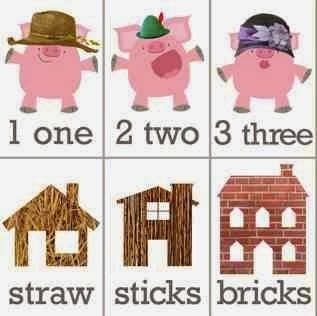 © www.peoniesandpoppyseeds.com
© www.peoniesandpoppyseeds.com From Pat-a-Cake Nursery Rhymes by Annie KublerEven in the tiny story of the nursery rhyme, the rhythm of three sets up the pattern of storytelling, in which the story is set up, there are three examples and then a turning point/conclusion:
From Pat-a-Cake Nursery Rhymes by Annie KublerEven in the tiny story of the nursery rhyme, the rhythm of three sets up the pattern of storytelling, in which the story is set up, there are three examples and then a turning point/conclusion:Set up the story: Pat a cake, Pat a cake, baker's man
Bake me a cake as fast as you can;
Now, build up the story with three elements:Pat it,and prick it and mark it with a ‘B’, Give it an outcome: And put it in the oven for baby and me.
When writing picture books, it is often handy to keep in mind how using the rule of three helps to deliver an exciting, page-turning plot and keep the narrative moving swiftly forward.
1. Sometimes, the whole plot is built upon the rule of three. For example, in Duck in a Truck, when Duck’s truck gets stuck in the muck, Jez Alborough uses three instances to resolve the main problem:
Frog hops down to help. Sheep tries to push. Then Goat, passing by in his motor boat, comes up with the clever plan that solves Duck’s problem:
 From Duck in a Truck by Jez Alborough
From Duck in a Truck by Jez Alborough
2. The rule of three is also a great tool for advancing the plot.
Once the author has set-up the story and its central problem, it can help to build-up suspense and work towards a clear turning point in the plot.
For instance, in That Rabbit Belongs to Emily Brown, the Queen wants Emily Brown’s much-loved rabbit Stanley in exchange for a golden teddy bear. Feisty Emily Brown tells the Chief Footman firmly that the rabbit is not for sale. So, the Queen sends:
1. The Army
 From That Rabbit Belongs to Emily Brown by Cressida Cowell and Neal Layton
From That Rabbit Belongs to Emily Brown by Cressida Cowell and Neal Layton2. The Navy
 From That Rabbit Belongs to Emily Brown by Cressida Cowell and Neal Layto
From That Rabbit Belongs to Emily Brown by Cressida Cowell and Neal Layto3. The Air Force
 From That Rabbit Belongs to Emily Brown by Cressida Cowell and Neal LaytoEach time, they try to exchange ‘Bunnywunny’ for an even greater number of outlandish gifts. And, with each spread, Emily Brown’s consistent refusal builds until she is “FED UP!”
From That Rabbit Belongs to Emily Brown by Cressida Cowell and Neal LaytoEach time, they try to exchange ‘Bunnywunny’ for an even greater number of outlandish gifts. And, with each spread, Emily Brown’s consistent refusal builds until she is “FED UP!” Then something must change in the pattern of the plot. So when the Queen has Stanley stolen, Emily Brown has no choice but to confront the Queen herself so she can tell her how to make the golden teddy as loveable as Stanley.
In another example, when Max is crowned King of the Wild Things in Sendak’s classic, three wordless spreads follow, adding drama and indicating the passage of time. These illustrate the wild things’ antics, building up to the turning point when Max orders the them to stop and sends them to bed. Then, realizing he’s lonely, he goes home to his supper and those who love him "best of all".
 From Where the Wild Things Are by Maurice Sendak
From Where the Wild Things Are by Maurice Sendak From Where the Wild Things Are by Maurice Sendak
From Where the Wild Things Are by Maurice Sendak From Where the Wild Things Are by Maurice Sendak
From Where the Wild Things Are by Maurice SendakOften, three consecutive examples can also help to advance a sub-section of the plot.
In the classic, Harry the Dirty Dog, when Harry comes home after having played by the railway, played tag with the other dogs and slid down the coal chute (three things!), he is no longer a white dog. His family are sure that this can't be Harry, so he:
“flip-flipped and flop-flipped”“rolled over and played dead” “danced and sang”

 From Harry the Dirty Dog by Gene Zion & Margaret Bloy GrahamBut, his family still don't recognize him . . . What follows is a moment of pause, before the story picks up again and Harry remembers to dig up the scrubbing brush he's hidden in the garden and ‘beg’ for a bath!
From Harry the Dirty Dog by Gene Zion & Margaret Bloy GrahamBut, his family still don't recognize him . . . What follows is a moment of pause, before the story picks up again and Harry remembers to dig up the scrubbing brush he's hidden in the garden and ‘beg’ for a bath!3. Sometimes, the rule of threes is even used like a mini-plot within the story, as in Olivia:
Olivia admires modern art at the museumShe tries it herself at home . . .
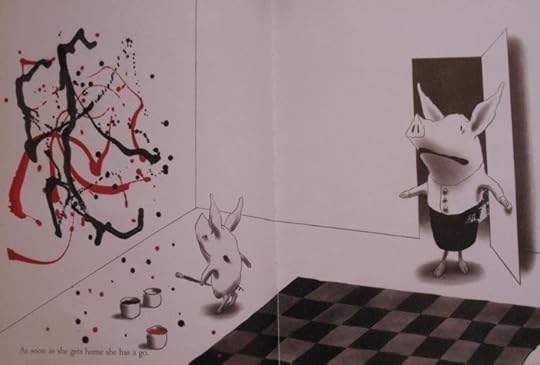 From Olivia by Ian Falconer 3. Then, “Time to think!“
From Olivia by Ian Falconer 3. Then, “Time to think!“ Or as a way to introduce some information about the characters (especially useful as an illustrative device across a page or a spread).
As in Quentin Blake’s Angelica Sprocket’s Pockets: “There’s a pocket for mice,” “and a pocket for cheese” “and a pocket for hankies in case anyone feels that they’re going to sneeze”
 From Angelica Sprocket's Pockets by Quentin Blake
From Angelica Sprocket's Pockets by Quentin BlakeIn Olivia, her morning routine includes three elements:
 From Olivia by Ian Falconer“In the morning, after she gets up and moves the cat,”“and brushes her teeth and combs her ears,”“and moves the cat”
From Olivia by Ian Falconer“In the morning, after she gets up and moves the cat,”“and brushes her teeth and combs her ears,”“and moves the cat”4. Finally, the rule of three is a really useful way to give the writing a satisfying rhythm.
Here are just two examples:
In Jane Clarke’s Knight School, Little Knight and Little Dragon discover that school is fun:
 From Knight School by Jane Clarke & Jane Massey “Little Knight and Little Dragon sang funny songs.“painted fabulous pictures,”“and listened to fantastic stories.”
From Knight School by Jane Clarke & Jane Massey “Little Knight and Little Dragon sang funny songs.“painted fabulous pictures,”“and listened to fantastic stories.”In Mo Willems’ Goldilocks and the Three Dinosaurs, by virtue of it being a spoof of Goldilocks and the Three Little Bears, practically the whole book follows the rule of three. Here is an example of how Willems uses it at the climax of the story, giving the page a great read-aloud rhythm:
“Just then a loud plane flew by, which sounded pretty much like a trio of Dinosaurs yelling
“NOW” or “CHARGE!” or the Norwegian expression for “CHEWY-BONBON-TIME!"
 From Goldilocks and the Three Bears by Mo Willems
From Goldilocks and the Three Bears by Mo WillemsThe rhythm of three is everywhere in picture books! If you look for it, you will start to see how it can work wonderfully to create predictable and unpredictable rhythms in your work, too.
Natascha BiebowAuthor, Editor and Mentor
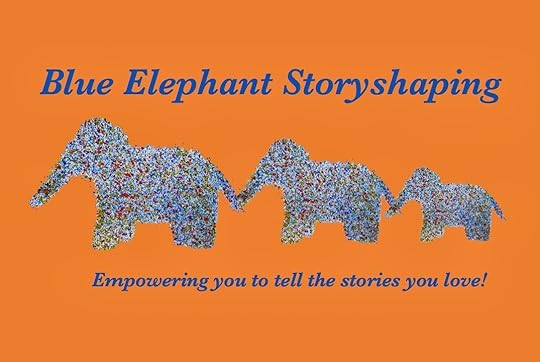 Blue Elephant Storyshaping is an editing, coaching and mentoring service aimed at empowering writers and illustrators to fine-tune their work pre-submission. Natascha is also the author of Elephants Never Forget and Is This My Nose?, editor of numerous award-winning children’s books, and Regional Advisor (Chair) of SCBWI British Isles. www.blueelephantstoryshaping.com
Blue Elephant Storyshaping is an editing, coaching and mentoring service aimed at empowering writers and illustrators to fine-tune their work pre-submission. Natascha is also the author of Elephants Never Forget and Is This My Nose?, editor of numerous award-winning children’s books, and Regional Advisor (Chair) of SCBWI British Isles. www.blueelephantstoryshaping.com
Published on February 18, 2014 23:30
February 14, 2014
Unleash Your Inner Rabbit by Jonathan Allen
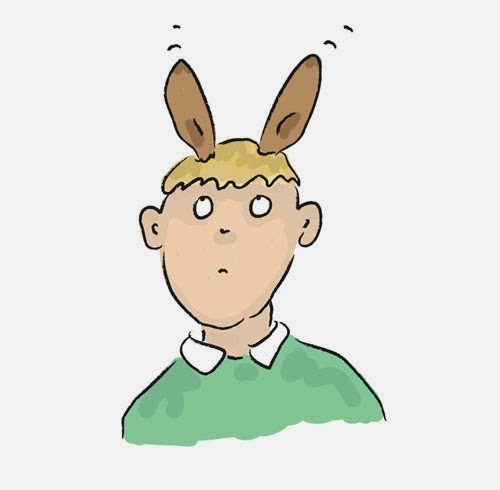
A few years ago, oh all right, more than a few years ago, I did a drawing workshop as part of day at Andover Library (I think it was there. . .). Anyway, it was concerned with drawing animals in a kid's book style, working from some stuffed animals the museum service had available. It was quite fun, and some nice drawings resulted. But it wasn't the results that made it interesting for me, it was the change of viewpoint it triggered. It made me look at what I do from an outsider's perspective and begin to see it as a process to be explored objectively.
Drawing for children's books, in my particular niche at least, is about simplifying. About reducing something to its essence and expressing that in a few lines. The interesting thing about this process is, that the essence you are reducing something to has as much to do with shared preconceptions as it has to do with physical reality.
I'll give an example of this in context. I was doing some drawing on a big flipchart while on a school visit, and as a bit of fun, I tried an experiment. Before I began to draw I asked the children to shout out as soon as they knew what animal I was drawing. I quickly drew two basic sausage shapes, sticking up vertically.
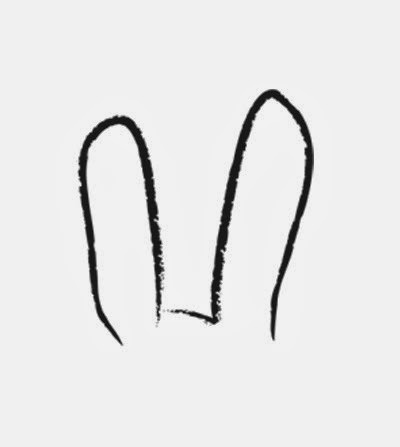
That was all that was needed. "Rabbit!" was the immediate response. I drew a long tube, thicker at one end, with an inverted 'v' at the thin end,
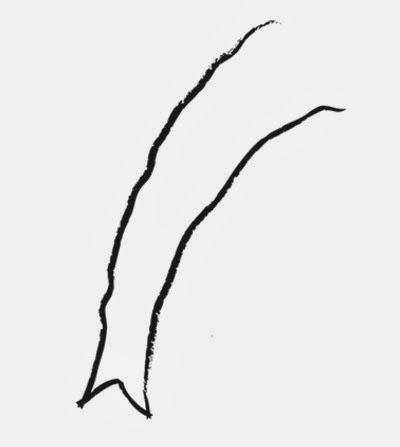
"Elephant!" came the cry almost immediately. They didn't need many visual clues at all. Some of them even got "Giraffe" straight away from one ear and the two knobbly bits on it's head, I didn't even have to draw the long neck!
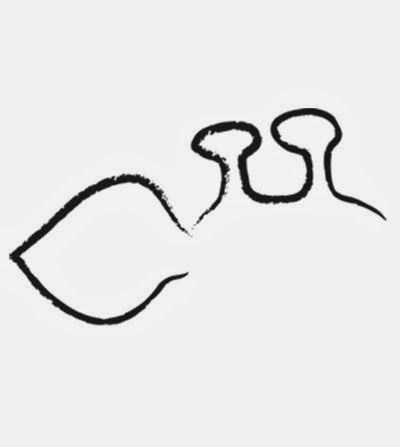
So what were they responding to? I think it was the idea of the particular animal that they were recognising. The shared concept of what a rabbit, for example, 'looks like' - what makes up a satisfactory rabbit according to our learned preconceptions. This shared concept would have been absorbed from children's books, cartoons and any other second or third hand manifestations of the collectively agreed Rabbit we carry within us, that they would have been exposed to. Some of it might have come from exposure to real rabbits, but not much.
Current scientific thinking seems to indicate that this mental process is a basic part of how the brain copes with the complexity of the visual world, by categorising and storing information into 'templates' to hold visual input up against, and guaging the relative importance of that visual input etc. We interpret the world on a 'need to know' basis, and our 'need to know' rabbit has -
1 - Big, sticky-up ears.
2 - Two prominent front teeth, though not 'fangs'.
3 - A white fluffy tail.
Which is why, in a Children's book, as long as a character has those attributes, it doesn't matter what shape or colour it is, what size it is, or whether it talks, wears clothes, or drives fork lift truck, everyone knows it's a Rabbit. Of course it is!
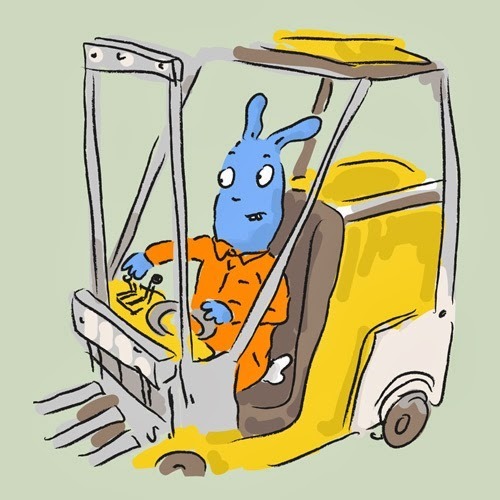 featuring my 'inner, need-to-know fork lift truck'. . .
featuring my 'inner, need-to-know fork lift truck'. . .
Published on February 14, 2014 00:30
Unleash Your Inner Rabbit

A few years ago, oh all right, more than a few years ago, I did a drawing workshop as part of day at Andover Library (I think it was there. . .). Anyway, it was concerned with drawing animals in a kid's book style, working from some stuffed animals the museum service had available. It was quite fun, and some nice drawings resulted. But it wasn't the results that made it interesting for me, it was the change of viewpoint it triggered. It made me look at what I do from an outsider's perspective and begin to see it as a process to be explored objectively.
Drawing for children's books, in my particular niche at least, is about simplifying. About reducing something to its essence and expressing that in a few lines. The interesting thing about this process is, that the essence you are reducing something to has as much to do with shared preconceptions as it has to do with physical reality.
I'll give an example of this in context. I was doing some drawing on a big flipchart while on a school visit, and as a bit of fun, I tried an experiment. Before I began to draw I asked the children to shout out as soon as they knew what animal I was drawing. I quickly drew two basic sausage shapes, sticking up vertically.

That was all that was needed. "Rabbit!" was the immediate response. I drew a long tube, thicker at one end, with an inverted 'v' at the thin end,

"Elephant!" came the cry almost immediately. They didn't need many visual clues at all. Some of them even got "Giraffe" straight away from one ear and the two knobbly bits on it's head, I didn't even have to draw the long neck!

So what were they responding to? I think it was the idea of the particular animal that they were recognising. The shared concept of what a rabbit, for example, 'looks like' - what makes up a satisfactory rabbit according to our learned preconceptions. This shared concept would have been absorbed from children's books, cartoons and any other second or third hand manifestations of the collectively agreed Rabbit we carry within us, that they would have been exposed to. Some of it might have come from exposure to real rabbits, but not much.
Current scientific thinking seems to indicate that this mental process is a basic part of how the brain copes with the complexity of the visual world, by categorising and storing information into 'templates' to hold visual input up against, and guaging the relative importance of that visual input etc. We interpret the world on a 'need to know' basis, and our 'need to know' rabbit has -
1 - Big, sticky-up ears.
2 - Two prominent front teeth, though not 'fangs'.
3 - A white fluffy tail.
Which is why, in a Children's book, as long as a character has those attributes, it doesn't matter what shape or colour it is, what size it is, or whether it talks, wears clothes, or drives fork lift truck, everyone knows it's a Rabbit. Of course it is!
 featuring my 'inner, need-to-know fork lift truck'. . .
featuring my 'inner, need-to-know fork lift truck'. . .
Published on February 14, 2014 00:30
February 8, 2014
The Inspiration For My Story - Group Post Part Two
As we had such good feed back from our previous joint blog we've decided to do a second one. Hope you enjoy!
Malachy Doyle
For me, the best books come out of something real. In this case, growing up in a big noisy family. Felicity, David, Gregory, Jim, Marian, Raphael, MALACHY, and four years later, Michael. Sometimes, at the bottom end of a big family, it's hard to get yourself heard. Sometimes it all gets a bit too much, and you want to run away and hide. So you do. And do they come looking for you? No. And do you miss them? A bit. Then a lot.
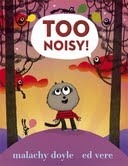
Moira Butterfield
The inspiration for 'Smile Baby Smile' came from my experience as a first-time young parent, when I didn't really know how to solve my son's crying and I tried all sorts of things, eventually discovering that he basically needed a big burp (that gives you a clue as to what finally makes the baby smile). When my second son and my niece came along there was a sense of the whole family joining in to try to help with the new arrival, and that's what happens in the book. The sentences are short and rhythmic, like a clapping song that we might sing to babies. I was trying to create a book that the whole family could use together when a new baby came along, because it is such a shared experience.
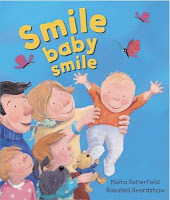
Paeony Lewis
Some of my stories were inspired by my children and one of these is No More Yawning! Oh, we had such terrible trouble getting my young daughter to go to sleep. We had a set,quiet bedtime routine (after a bath, there were always lots of stories, though nothing too bouncy!) and she'd assure us she was trying really hard to sleep. But by 10pm, 11pm or even midnight, my daughter would still be adamant it wasn't her fault she hadn't fallen asleep. We tried everything (they're in the story) and the one that helped most is the one I used when I was a child, so of course it's the one that works for Florence in the story. This is one book I couldn't have written without the experience (frustration!) of being a parent, albeit it's not the case for every story.
By the way, since writing the story I've heard (and discovered for myself) that if you get the child to join in the yawning, they'll start yawning for real and get sleepy. Yawning is infectious!
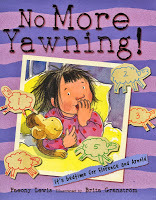
Now we've shared what inspired us. If you're a writer we'd love to know what inspired you to write one of your books.
Malachy Doyle
For me, the best books come out of something real. In this case, growing up in a big noisy family. Felicity, David, Gregory, Jim, Marian, Raphael, MALACHY, and four years later, Michael. Sometimes, at the bottom end of a big family, it's hard to get yourself heard. Sometimes it all gets a bit too much, and you want to run away and hide. So you do. And do they come looking for you? No. And do you miss them? A bit. Then a lot.

Moira Butterfield
The inspiration for 'Smile Baby Smile' came from my experience as a first-time young parent, when I didn't really know how to solve my son's crying and I tried all sorts of things, eventually discovering that he basically needed a big burp (that gives you a clue as to what finally makes the baby smile). When my second son and my niece came along there was a sense of the whole family joining in to try to help with the new arrival, and that's what happens in the book. The sentences are short and rhythmic, like a clapping song that we might sing to babies. I was trying to create a book that the whole family could use together when a new baby came along, because it is such a shared experience.

Paeony Lewis
Some of my stories were inspired by my children and one of these is No More Yawning! Oh, we had such terrible trouble getting my young daughter to go to sleep. We had a set,quiet bedtime routine (after a bath, there were always lots of stories, though nothing too bouncy!) and she'd assure us she was trying really hard to sleep. But by 10pm, 11pm or even midnight, my daughter would still be adamant it wasn't her fault she hadn't fallen asleep. We tried everything (they're in the story) and the one that helped most is the one I used when I was a child, so of course it's the one that works for Florence in the story. This is one book I couldn't have written without the experience (frustration!) of being a parent, albeit it's not the case for every story.
By the way, since writing the story I've heard (and discovered for myself) that if you get the child to join in the yawning, they'll start yawning for real and get sleepy. Yawning is infectious!

Now we've shared what inspired us. If you're a writer we'd love to know what inspired you to write one of your books.
Published on February 08, 2014 23:00
February 4, 2014
Why do some picture books stay in print for decades? by Paeony Lewis
 Some picture books go out of print in a year, whilst others stay in print for twenty, thirty or fifty years. Is it because these perennial favourites are outstanding? Or is it because some books quickly become dated? For example, times change, and I couldn’t resist including an original illustration (by Peggy Fortnum) from the young chapter book Paddington at Large (1962). It shows Paddington smoking a cigar. He wasn't being a naughty, unhealthy Paddington in the 1960s!
Some picture books go out of print in a year, whilst others stay in print for twenty, thirty or fifty years. Is it because these perennial favourites are outstanding? Or is it because some books quickly become dated? For example, times change, and I couldn’t resist including an original illustration (by Peggy Fortnum) from the young chapter book Paddington at Large (1962). It shows Paddington smoking a cigar. He wasn't being a naughty, unhealthy Paddington in the 1960s!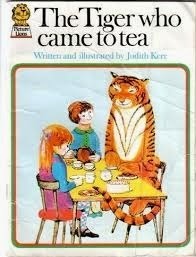 My musings about the longevity of picture books began when a friend asked me why books like Judith Kerr's The Tiger Who Came To Tea stay in print (first published 1968). My friend wondered what it was that keeps some books in print. My initial answer was to say that if a child enjoyed a book when they were young, then they’d remember and buy it to share with their children. But now I'm not so sure.
My musings about the longevity of picture books began when a friend asked me why books like Judith Kerr's The Tiger Who Came To Tea stay in print (first published 1968). My friend wondered what it was that keeps some books in print. My initial answer was to say that if a child enjoyed a book when they were young, then they’d remember and buy it to share with their children. But now I'm not so sure.I suspect grandparents may play a more important role in keeping picture books in print. As parents, we remember which books we enjoyed sharing with our children (these may, or may not, also be the children’s favourites). Then when the parents become grandparents, if they see the book in a shop they become nostalgic and buy the book for their grandchildren.
 By Paeony Lewis, illus by Penny IvesWhat evidence do I have to back this up? Not a lot! However, my I’ll Always Love You is now a scary 14 years old and although it's not in the same category as the classics, I've begun getting lovely emails from new grandparents telling me they’re buying the book for their grandchild because they remember reading this story of unconditional love to their child. These grandparents tend to be American as it's especially popular there and a new bookshop edition has just come out.
By Paeony Lewis, illus by Penny IvesWhat evidence do I have to back this up? Not a lot! However, my I’ll Always Love You is now a scary 14 years old and although it's not in the same category as the classics, I've begun getting lovely emails from new grandparents telling me they’re buying the book for their grandchild because they remember reading this story of unconditional love to their child. These grandparents tend to be American as it's especially popular there and a new bookshop edition has just come out.Thank you grandparents, but why have I discounted my theory about parents buying picture books that they enjoyed when they were children? I'm sure there are exceptions, but my gut says there are two reasons why it's not necessarily new parents (OK, my gut isn't scientific, so feel free to disagree!).
Firstly, do all adults remember and reminisce about the picture books they enjoyed as children? I do, but I work in the world of picture books and still have my old books, so I'm not necessarily typical. I asked my ‘children’ (21 and 19) which picture books they remembered liking, and they struggled. YES, THEY STRUGGLED! I feel miffed!
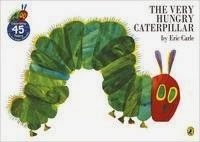 First published 1969One forgetful child admitted there were so many picture books it was hard to remember (interesting, when I was a child I had just a few that were looked at continuously). The glorious The Very Hungry Caterpillar was the only one remembered by my son, but he claimed no strong emotional attachment to it.
First published 1969One forgetful child admitted there were so many picture books it was hard to remember (interesting, when I was a child I had just a few that were looked at continuously). The glorious The Very Hungry Caterpillar was the only one remembered by my son, but he claimed no strong emotional attachment to it.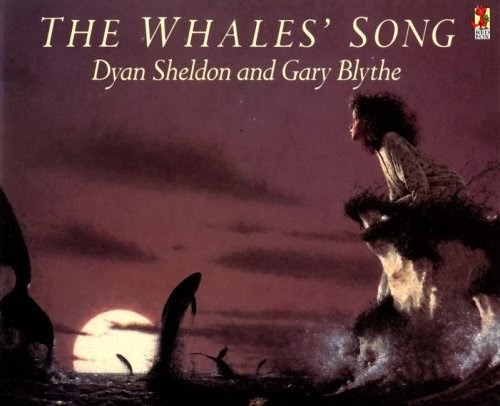 First published 1990My daughter particularly remembered one evocative book about a whale and after a discussion she agreed it was The Whale’s Song. I knew she adored that one because I read it to her over and over and over again. I also mentioned others I knew she had adored, but she had no memory of these once-favourite books. Perhaps if I’d dug them out she’d have recognised them, although she denies remembering Demon Teddy, despite being shown the damming evidence that once upon a time she liked him (see image!).
First published 1990My daughter particularly remembered one evocative book about a whale and after a discussion she agreed it was The Whale’s Song. I knew she adored that one because I read it to her over and over and over again. I also mentioned others I knew she had adored, but she had no memory of these once-favourite books. Perhaps if I’d dug them out she’d have recognised them, although she denies remembering Demon Teddy, despite being shown the damming evidence that once upon a time she liked him (see image!). Somebody liked Nicolas Allan's Demon Teddy!
Somebody liked Nicolas Allan's Demon Teddy!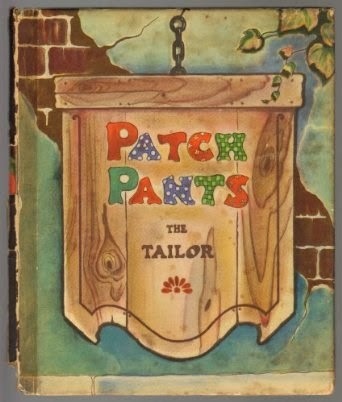 By George ChristianIf I have grandchildren (no pressure, my dearest children…) I know I’ll be buying them new picture books as well as books that fill me with nostalgia for the days when they were tiny and we curled up together to share books. However, I never shared or bought my children the picture books I adored as a child. Why’s that? I've decided it’s because they’re too personal, aren't necessarily great, and they are a product of their time and most aren't in print. Even so, I’ll share three with you (and perhaps more another time).
By George ChristianIf I have grandchildren (no pressure, my dearest children…) I know I’ll be buying them new picture books as well as books that fill me with nostalgia for the days when they were tiny and we curled up together to share books. However, I never shared or bought my children the picture books I adored as a child. Why’s that? I've decided it’s because they’re too personal, aren't necessarily great, and they are a product of their time and most aren't in print. Even so, I’ll share three with you (and perhaps more another time). Patch Pants the TailorI'm sure nobody has heard of Patch Pants the Tailor. A strange book and inappropriate (we were embarrassingly ignorant in the 1960s and it was first published in 1947). However, I adored this book and I think it was because Patch was unhappy and wanted more from life than patching and mending clothes, so he sailed in a boat with Salty the sailor and they were wrecked on a clichéd tropical island complete with 'natives' they suspected were cannibals (I told you it was embarrassing). Anyway, Patch sets up shop on the island and lives happily ever after. And why did I like it? My inner pop psychologist says it was because I was unhappy at home and wanted to escape (probably true as I did make up detailed plans for running away!).
Patch Pants the TailorI'm sure nobody has heard of Patch Pants the Tailor. A strange book and inappropriate (we were embarrassingly ignorant in the 1960s and it was first published in 1947). However, I adored this book and I think it was because Patch was unhappy and wanted more from life than patching and mending clothes, so he sailed in a boat with Salty the sailor and they were wrecked on a clichéd tropical island complete with 'natives' they suspected were cannibals (I told you it was embarrassing). Anyway, Patch sets up shop on the island and lives happily ever after. And why did I like it? My inner pop psychologist says it was because I was unhappy at home and wanted to escape (probably true as I did make up detailed plans for running away!).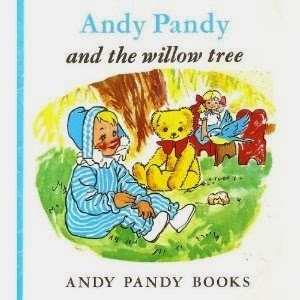 There's one small picture book that I did buy again (only for me), and that's because the original was lost on a trip to a garden centre. A relative wasn't sure he'd recognise a weeping willow tree, so I lent him my ancient copy of Andy Pandy and the Willow Tree. I'd always loved the images of the 'toys' having a picnic deep inside the green tent of dappled leaves. It seemed magical and I even included a picnic under a willow tree in a story that was almost published. One day...
There's one small picture book that I did buy again (only for me), and that's because the original was lost on a trip to a garden centre. A relative wasn't sure he'd recognise a weeping willow tree, so I lent him my ancient copy of Andy Pandy and the Willow Tree. I'd always loved the images of the 'toys' having a picnic deep inside the green tent of dappled leaves. It seemed magical and I even included a picnic under a willow tree in a story that was almost published. One day...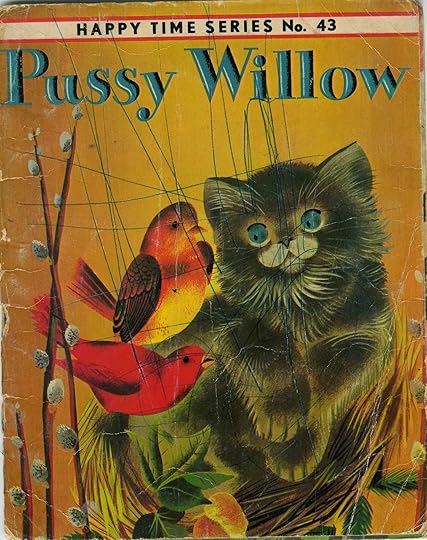 My 'annotated' 1963 edition.
My 'annotated' 1963 edition. By Margaret Wise Brown,
Illus by Leonard Weisgard Another book that made a visual impression was Pussy Willow. I remember enjoying the illustrations and the flowery language of Margaret Wise Brown, and I still have a soft spot for pussy willow in the spring (and cats).
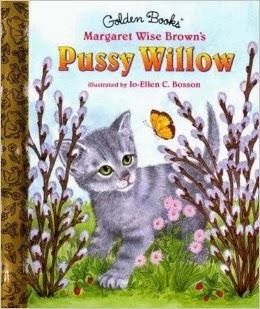 New 1997 illustrations - not for me.It was originally published in 1951 and my edition is 1963. I've discovered a 1997 edition with new sugary illustrations. Why did they do this? If something is an old favourite, why change the illustrations? Nobody would re-illustrate The Gruffalo, Where the Wild Things Are, Owl Babies, Peepo or Madeline (oops, I've just checked and there are new illustrations for a Madeline series, sigh).
New 1997 illustrations - not for me.It was originally published in 1951 and my edition is 1963. I've discovered a 1997 edition with new sugary illustrations. Why did they do this? If something is an old favourite, why change the illustrations? Nobody would re-illustrate The Gruffalo, Where the Wild Things Are, Owl Babies, Peepo or Madeline (oops, I've just checked and there are new illustrations for a Madeline series, sigh).It's about time I returned to the original topic. Why do some picture books keep on going? Are grandparents key to a book staying in print for several decades? I think so, although a book has to be popular to begin with, and stay in print (that's vital, and media tie-ins help with this). Plus I feel it needs to be the sort of book that is either utterly brilliant or has an emotional pull that evokes loving memories. So what makes a classic book that stays in print? Tricky! There are lots of wonderful books that haven't lasted decades. Any suggestions for resurrections?
Paeony Lewis
www.paeonylewis.com
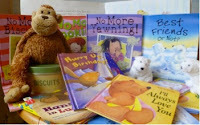
Published on February 04, 2014 00:00
January 30, 2014
Do The Boys Get All The Fun? By Pippa Goodhart
No they don't, but they just might get more than their fair share when it comes to picture books. In early November I was emailed some questions by illustrations student Harjit Kaur. She specialises in picture books, and was asking questions to do with her dissertation. I answered her questions about why I might choose to use animal characters rather than human ones, whether or not publishers had a preference between the two options ... and then I was completely halted in my tracks by this question: 'Does the gender disparity in anthropomorphic characters in children's picture books make you less inclined to having female protagonists?' Well I have to admit that I hadn't noticed any gender disparity in anthropomorphic characters, but Harjit kindly sent me links to some learned academic papers discussing exactly that. Those papers went into complex detail about the dominant/subservient roles of male and female characters, geographical origins of different gender trends, the influence of the picture book examples chosen on young children's developing perceptions of the different genders, and so on. My own perception of current children's books had been that we'd got the balance about right in the picture book area, although I very much dislike the present trend for pink fairy princess girly books as something quite separate from the snot, underpant and sometimes violent 'boys'' books in the book formats that come after picture books. Surely we do better than that in picture books? So I decided to do a small, and not very scientific, experiment. I simply went through the first hundred picture books reviewed online by Books for Keeps. Some of those books had no lead character, or the sex of the lead character wasn't clear in the review or cover artwork, in which case I left them out of the count. But for the hundred with a clear lead character the results were -Male lead 68%Female lead 32% That's quite a difference. But, perhaps more interestingly, the split between male and female anthropomorphic characters (I'm including robots, monsters, teddy bears and yetis here!) were even more startling. Removing human characters, we get the following neat percentages -Male anthropomorphic lead characters 80%Female anthropomorphic lead characters 20% My flabber is truly ghasted by those figures! I'd no idea. So, why do we trend so heavily towards making animal or alien or toy characters male? Is it a problem? If so, why? I'm glad to say that my most recently published picture book features a female anthropomorphic lead ... and the one I'm working on has a female alien, thanks to Harjit!
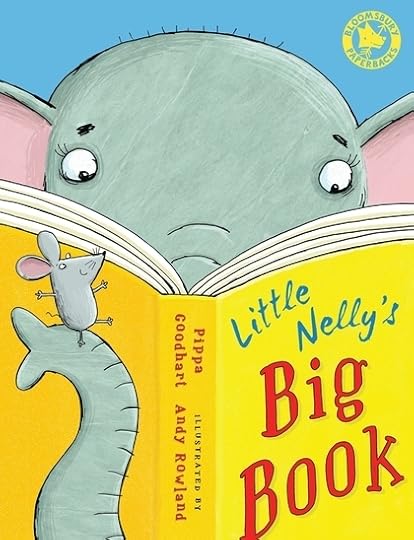

Published on January 30, 2014 01:19
January 25, 2014
Seven picture book predictions
Moira ButterfieldAs it’s a new year I have decided to look into my crystal ball to see the future. Well, I DO live near Glastonbury, you know! It’s basically Wizard Central in the UK, and it's easier to buy a crystal ball than a carton of milk there.
 Looking into my crystal ball. Not.Oh, alright. I admit it. I don’t really have a crystal ball, so please don’t hold me to any of my predictions.
Looking into my crystal ball. Not.Oh, alright. I admit it. I don’t really have a crystal ball, so please don’t hold me to any of my predictions. In 2014 I foresee personal jetpacks, flying cars and houseworking robots for every home, obviously. That goes without saying.
 My personal jetpack, expected in 2014.
My personal jetpack, expected in 2014.But what about picture books? Now I will try to use my magic powers…..
1. I foresee more picture books connected to online sites or Apps providing extra material - not just e-book versions but all sorts of activities and extra words. This will be done in clever new ways, involving swiping or pointing a smart phone at some part of the book. Hopefully authors will be asked to help produce the online material, to make it imaginative. You may or may not wish to be involved, but I guess you need to be aware of whether you do or not when you sign contracts (I foresee getting a knowledgeable agent to blog about that side of things here on Picture Book Den in 2014).
STOP PRESS; Since I did the first draft of this blog I’ve been asked to work on a series of books that connect to Apps, so that prediction has already come true for me. Maybe I DO have magic powers...Cool!
2. To compete in a digital age, books for adults are increasingly packaged with beautiful binding and cover effects to make them extra-desirable physical objects (check out the lovely new Gollancz Terry Pratchett Mort books being published in the UK as an example). Perhaps the same will happen with picture books. We may see more beautiful ‘must have’ editions of favourites, not just the usual paperbacks and board books.
3. We are already seeing more and more books reprinted with added physical extras –such as pressout card models excetera. Authors might like to spend a little time thinking of their own list of suggested extra elements and offer this creative thinking to publishers, if appropriate.They might ignore you, in which case no harm done, but I'd have thought they're more likely to be pleased.
4. I foresee publishers asking authors to make more and more personal effort to publicise their own work. That means being active online. It’s not easy, but we shouldn’t panic that we’re not on Twitter, Instagram, Facebook, Pinterest and Blatherbox (It’s ok. I made that one up). We should do what we’re comfortable with and have time for. We should try to add some kind of value to the digital universe when we can, and not simply ‘sell, sell, sell’.
5. I foresee more classic well-sold picture books being taken apart and reconstituted to create early learning ranges (eg: a counting book, a colours book etc etc). This is happening a lot. Nothing wrong with that, but it would be nice to see some more imaginatively reconstituted material in 2014.
6. The future of self-published digital e-picture books is very hard to predict. Amazon.com has been flooded with a tide of awful tat produced in the Far East, so it’s hard for professional independents to get noticed or make any money. I produced some bespoke ebooks in 2012 with Gerry Hawksley, but we were thoroughly demotivated in 2013 by the tat tide and by the capricious behaviour of Amazon. We have to get our mojo back on that one. Apps are very expensive for an independent author to produce, so it doesn't seem worth it. Sorry, my crystal ball has gone foggy here and I don’t have any predictions as yet. Perhaps there will be a gamechanger – a big 52-shades style hit that gets everybody thinking differently.
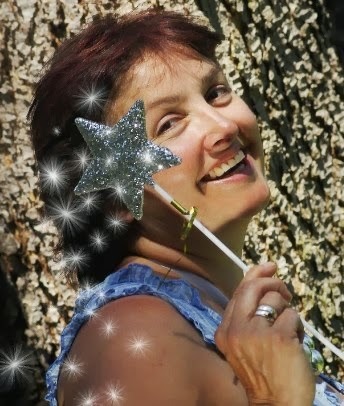 Off to try my new wand.
Off to try my new wand.7. I don't yet foresee a big picture book hit in 2014. That’s not because there won’t be one, but because it’s impossible to predict where it will come from. That’s a good thing, people! Keep writing!
www.moirabutterfield.com@moiraworld
Published on January 25, 2014 01:05



